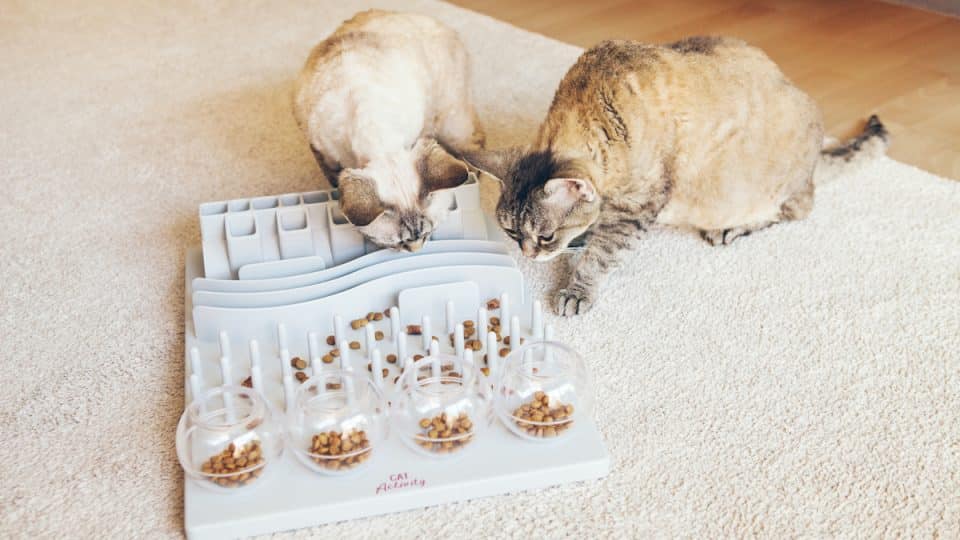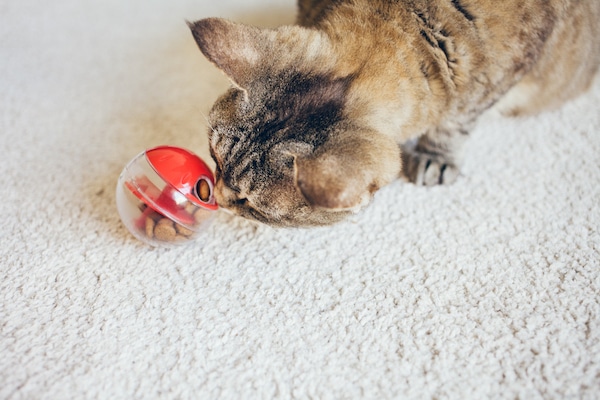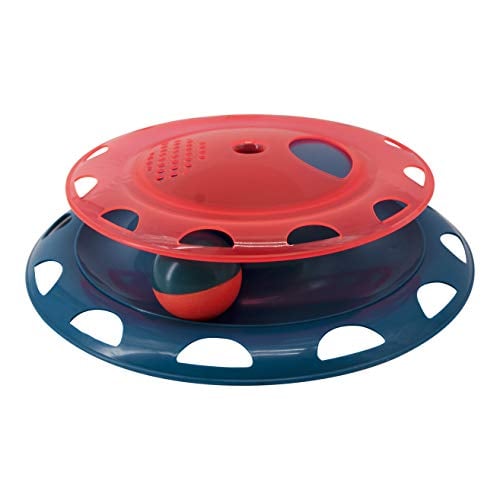- This post contains affiliate links. Read more here.
- Not a substitute for professional veterinary help.
Cat puzzle toys are gaining popularity, and some pretty extraordinary claims have been made about their benefits—including preventing regurgitation, aiding in weight loss, decreasing behavioral issues, and reducing anxiety.
But what does the science say? Do our cats really need puzzle toys to stay healthy and happy? To find out, we interview Liv Healy of Clicker Kittens, a certified fear-free animal trainer (FFCP), professional canine behavioral consultant (CBCC-KA), and co-owner of Clickstart Dog Training Academy.
How Cat Puzzle Toys Work
According to Healy, the goal behind cat puzzle toys is to give outlets for normal, species-specific behaviors like sniffing, stalking, chasing, and pouncing. “We’re borrowing concepts from the zoological community, specifically building enrichment frameworks to encourage natural behaviors in captive environments,” they say.
Healy points out that animal enrichment is typically broken down into five categories—physical or structural, nutritional/food-based, social, sensory, and cognitive. They add that different types of puzzle toys can help pet parents accomplish these varying areas of enrichment.
But there’s a catch when it comes to food puzzle toys. Healy says that while most animals demonstrate a phenomenon called contrafreeloading—a preference to work for food rather than getting it “for free” (we see you, working dog breeds)—cats do not.
-
insonnia via iStock
“Interestingly, domestic cats are one of the few animals on the planet that don’t seem to contrafreeload,” Healy says, referencing a study by the University of California. “Despite this, many trainers and pet parents have reported cats who do opt for the puzzle toy over the food bowl,” they add.
Even if your cat isn’t interested in working for their food, don’t fret. There are still plenty of other non-food-related puzzle toys out there!
Unpacking Cat Puzzle Toy Claims—What the Experts Say
Cat puzzle toys claim to have a wide variety of benefits, including keeping cats from regurgitating their food. Healy agrees that they’re effective in helping prevent this cat quirk.
“Puzzle feeders can be a fabulous way to keep your cat from wolfing down their food in T-minus 2 seconds,” they say. “Although if your cat is eating alarmingly quickly or vomiting, it’s always worth chatting with your vet just in case.”
Some pet parents also use cat puzzle toys in the hopes that they’ll provide extra exercise for their cats. But Healy points out that it all really depends on what kind of puzzle toy you use.
“A snuffle mat might not encourage as much movement as, for example, a treat dispensing ball that needs to be batted around or chased,” they say. “With my own cats, I’ve used a treat-and-train food dispenser to set them up to race up and down the hallway over a small series of jumps to access their treats, which does get them pretty fatigued quickly!”
When it comes to combating behavioral issues, Healy says puzzle toys can help by being such an amazing source of mental stimulation.
“Boredom, lack of exercise, and lack of enrichment can contribute to many common cat behavior problems including cat-cat conflict, destructive behaviors, nighttime ‘zoomies,’ and more,” they say. “Puzzle toys, clicker training, and other types of enrichment are almost always part of a behavior modification plan.”
@clickerkittens Answer to @aneksii
And what about anxiety? Can cat puzzle toys help your cat feel less stressed? According to Healy, yes, they can. “Increased environmental enrichment is commonly used as a stress reduction strategy in zoos, animal shelters, and homes,” they point out.
“Encouraging interaction with food-dispensing puzzles can broaden an anxious cat’s behavioral repertoire, build positive associations by way of delicious snacks, and help relieve boredom.”
Choosing the Best Puzzle Toy for Your Cat
With so many cat puzzle toys on the market, how do you even begin to choose? A good place to start is by paying close attention to your cat’s likes/dislikes and overall behavior—do they prefer to chase, swat, dig, or lick? You’ll also want to pick toys that suit their ability and skill level.
For beginners or cats who get easily frustrated, a simple but entertaining stationery design like the KONG Puzzlements Pockets Cat Toy is a great place to start. This quilted toy has nine different play pockets to hide toys and treats, activating hunting and foraging instincts. Adding extra sensory enrichment, this cat puzzle toy includes a rattling yarn ball, crinkly material, and a catnip mouse.
Chase toys are ideal for both cats who have excess energy to burn and those who need help adding a little exercise to their daily routine. The PetSafe SlimCat Meal-Dispensing Ball, for example, adds movement to mealtime.Adjustable openings allow for a slower or faster feed, giving you more options to cater to your cat’s ability and energy levels.
If your cat isn’t motivated to work for their food (hello, anti-contrafreeloader), a chase track puzzle like this Petstages toy provides a good alternative—and it comes with a catnip compartment.
If your cat does enjoy working for their food, feeder toys can provide excellent mental stimulation. They can also slow your cat down during mealtime, helping you both avoid the not-so-fun aftermath affectionately known as “scarf and barf.”
Cat feeder toys range from simple puzzles to ones with a variety of challenges like the TRIXIE 5-in-1 Activity Fun Board. From licking to digging, this interactive feeder encourages your cat to use all of their senses in a variety of ways.
When picking out a puzzle toy for your cat, Healy says to look out for loose parts, dangling strings, or any other pieces that could become choking or impaction hazards.
The most important watchout for pet parents, however, is frustration. “If your cat is brand new to puzzle feeders, take some time to show them how to use it and make sure they get some high-value treats pretty easily at first,” they say. “A cat who is ignoring their beautiful new puzzle toy probably isn’t just being ‘stubborn,’ but they might be confused and need help.”
For more cat puzzle toys, visit “Clever Cat Puzzle Toys To Challenge Your Savvy Feline.”
Does Your Cat Need Puzzle Toys?
If you can fit it into your budget, then yes. Enrichment adds so many benefits to your cat’s life, so if you’re able to swing it, then puzzle toys can be a great addition to your cat’s training, exercise routine, mental health, and behavior modification plan.
The great thing about enrichment, however, is that it doesn’t have to be expensive. Sure there are elaborate puzzle toys with all the bells and whistles, but adding a few basics to your collection can go a long way. And if you have the patience and time to make your own, that’s also a budget-friendly way to go.
@clickerkittens Jude just turned 5 and still suffers from the Too Much gene (and also some mystery neuro issues). This game is a staple for our collective sanity
In particular, we think cat puzzle toys are a good fit for:
- Cats who eat too quickly and need help slowing down
- Cats who experience environmental anxiety
- Energetic kitties or overweight cats who could benefit from more exercise
- Pet parents who are creating a full-picture behavioral modification plan
Puzzle toys, however, might not be the best enrichment choice for some cats, including:
- Toy-shredders and super chewers
- Cats who are easily prone to frustration
- Cats who aren’t food or chase motivated
How We Chose Our Cat Puzzle Toys
The cat puzzle toys featured here were selected based on a combination of our own hands-on testing, a comprehensive look at customer reviews across a wide variety of retail platforms, and interviews with behavioral experts. We selected these puzzle toys based on durability, texture, and versatility.
We’re also guided by the experience of living and playing alongside our own much-loved and strongly opinionated pets, who are never stingy with their feedback.







